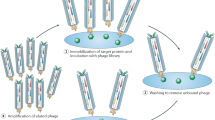Abstract
Cyclic peptides are an important class of molecules that are increasingly viewed as an ideal scaffold for inhibition of protein–protein interactions (PPI). Here we detail an approach that enables the intracellular synthesis of cyclic peptide libraries of around 108 members. The method utilizes split intein mediated circular ligation of peptides and proteins (SICLOPPS), taking advantage of split intein splicing to cyclize a library of peptide sequences. SICLOPPS allows the ring size, set residues and number of random residues within a library to be predetermined by the user. SICLOPPS libraries have been combined with a variety of cell-based screens to identify cyclic peptide inhibitors of a variety of enzymes and protein–protein interactions.
Access this chapter
Tax calculation will be finalised at checkout
Purchases are for personal use only
Similar content being viewed by others
References
Hughes JP, Rees S, Kalindjian SB, Philpott KL (2011) Principles of early drug discovery. Br J Pharmacol 162(6):1239–1249
Drews J (1996) Genomic sciences and the medicine of tomorrow. Nat Biotechnol 14(11):1516–1518
Boldt GE, Dickerson TJ, Janda KD (2006) Emerging chemical and biological approaches for the preparation of discovery libraries. Drug Discov Today 11(3–4):143–148
Brey DM, Motlekar NA, Diamond SL, Mauck RL, Garino JP, Burdick JA (2011) High-throughput screening of a small molecule library for promoters and inhibitors of mesenchymal stem cell osteogenic differentiation. Biotechnol Bioeng 108(1):163–174
Kneller R (2010) The importance of new companies for drug discovery: origins of a decade of new drugs. Nat Rev Drug Discov 9(11):867–882
Liu RW, Marik J, Lam KS (2003) Design, synthesis, screening, and decoding of encoded one-bead one-compound peptidomimetic and small molecule combinatorial libraries. Methods Enzymol 369:271–287
Lennard KR, Tavassoli A (2014) Peptides Come round: using SICLOPPS libraries for early stage drug discovery. Chemistry 20(34):10608–10614
Angelini A, Cendron L, Chen S, Touati J, Winter G, Zanotti G, Heinis C (2012) Bicyclic peptide inhibitor reveals large contact interface with a protease target. ACS Chem Biol 7(5):817–821
Goto Y, Katoh T, Suga H (2011) Flexizymes for genetic code reprogramming. Nat Protoc 6(6):779–790
Ito K, Passioura T, Suga H (2013) Technologies for the synthesis of mRNA-encoding libraries and discovery of bioactive natural product-inspired non-traditional macrocyclic peptides. Molecules 18(3):3502–3528
Scott CP, Abel-Santos E, Wall M, Wahnon DC, Benkovic SJ (1999) Production of cyclic peptides and proteins in vivo. Proc Natl Acad Sci 96(24):13638–13643
Tavassoli A, Benkovic SJ (2005) Genetically selected cyclic-peptide inhibitors of AICAR transformylase homodimerization. Angew Chem Int Ed Engl 44(18):2760–2763
Timmerman P, Beld J, Puijk WC, Meloen RH (2005) Rapid and quantitative cyclization of multiple peptide loops onto synthetic scaffolds for structural mimicry of protein surfaces. Chembiochem 6(5):821–824
Tavassoli A, Benkovic SJ (2007) Split-intein mediated circular ligation used in the synthesis of cyclic peptide libraries in E-coli. Nat Protoc 2(5):1126–1133
Liskamp RMJ, Rijkers DTS, Kruijtzer JAW, Kemmink J (2011) Peptides and proteins as a continuing exciting source of inspiration for peptidomimetics. Chembiochem 12(11):1626–1653
Menegatti S, Hussain M, Naik AD, Carbonell RG, Rao BM (2013) mRNA display selection and solid-phase synthesis of Fc-binding cyclic peptide affinity ligands. Biotechnol Bioeng 110(3):857–870
Kinsella TM, Ohashi CT, Harder AG, Yam GC, Li WQ, Peelle B, Pali ES, Bennett MK, Molineaux SM, Anderson DA, Masuda ES, Payan DG (2002) Retrovirally delivered random cyclic peptide libraries yield inhibitors of interleukin-4 signaling in human B cells. J Biol Chem 277(40):37512–37518
Kritzer JA, Hamamichi S, McCaffery JM, Santagata S, Naumann TA, Caldwell KA, Caldwell GA, Lindquist S (2009) Rapid selection of cyclic peptides that reduce [alpha]-synuclein toxicity in yeast and animal models. Nat Chem Biol 5(9):655–663
Horswill AR, Savinov SN, Benkovic SJ (2004) A systematic method for identifying small-molecule modulators of protein-protein interactions. Proc Natl Acad Sci U S A 101(44):15591–15596
Asby DJ, Cuda F, Beyaert M, Houghton FD, Cagampang FR, Tavassoli A (2015) AMPK activation via modulation of de novo purine biosynthesis with an inhibitor of ATIC homodimerization. Chem Biol 22(7):838–848
Spurr IB, Birts CN, Cuda F, Benkovic SJ, Blaydes JP, Tavassoli A (2012) Targeting tumour proliferation with a small-molecule inhibitor of AICAR transformylase homodimerization. Chembiochem 13(11):1628–1634
Birts CN, Nijjar SK, Mardle CA, Hoakwie F, Duriez PJ, Blaydes JP, Tavassoli A (2013) A cyclic peptide inhibitor of C-terminal binding protein dimerization links metabolism with mitotic fidelity in breast cancer cells. Chem Sci 4(8):3046–3057. doi:10.1039/C3sc50481f
Miranda E, Nordgren IK, Male AL, Lawrence CE, Hoakwie F, Cuda F, Court W, Fox KR, Townsend PA, Packham GK, Eccles SA, Tavassoli A (2013) A cyclic peptide inhibitor of HIF-1 heterodimerization that inhibits hypoxia signaling in cancer cells. J Am Chem Soc 135(28):10418–10425
Warren DJ (2011) Preparation of highly efficient electrocompetent Escherichia coli using glycerol/mannitol density step centrifugation. Anal Biochem 413(2):206–207
Naumann TA, Savinov SN, Benkovic SJ (2005) Engineering an affinity tag for genetically encoded cyclic peptides. Biotechnol Bioeng 92(7):820–830
Author information
Authors and Affiliations
Corresponding author
Editor information
Editors and Affiliations
Rights and permissions
Copyright information
© 2017 Springer Science+Business Media New York
About this protocol
Cite this protocol
Osher, E.L., Tavassoli, A. (2017). Intracellular Production of Cyclic Peptide Libraries with SICLOPPS. In: Mootz, H. (eds) Split Inteins. Methods in Molecular Biology, vol 1495. Humana Press, New York, NY. https://doi.org/10.1007/978-1-4939-6451-2_3
Download citation
DOI: https://doi.org/10.1007/978-1-4939-6451-2_3
Published:
Publisher Name: Humana Press, New York, NY
Print ISBN: 978-1-4939-6449-9
Online ISBN: 978-1-4939-6451-2
eBook Packages: Springer Protocols




